|
Design and Technical
Information
The Hand Drill No. 655 was not a unique design. It evolve from
Hand Drill No. 4-1/2 introduced around 1896.
The design of the Hand Drill No. 4-1/2 was based on a patent
awarded to Herbert D. Lanfair
in August 13, 1895 under the No. 544,411 and was assigned to
Goodell Brothers Company.
It included a design for a hand drill and several important
parts of that drill. It was one of the most important patents,
secured by Goodell Brothers Co. Some patented parts of the drill
were easily adoptable to other products that the company planned
to produce. Herbert D. Lanfair described his invention as
follows:
It was one of
the most important patents, secured by Goodell Brothers Co.
Some patented parts of the drill were easily adoptable to
other products that the company planned to produce. Herbert D. Lanfair described his invention as follows:
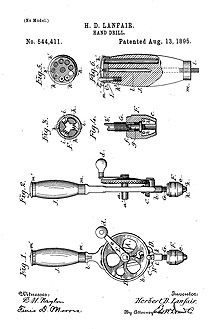 "My
invention is an improvement in drills chiefly for use of
woodworking mechanics. It has for its object to provide a drill
mechanism which will easy to operate and multiply the
revolutions of the drill-bit with reference to those of the
crank. "My
invention is an improvement in drills chiefly for use of
woodworking mechanics. It has for its object to provide a drill
mechanism which will easy to operate and multiply the
revolutions of the drill-bit with reference to those of the
crank.
It consists essentially, first, of an improved chuck for the
drill wherein the drill-holding jaws are separated by springs
and held in place by housing interiorly screw-threaded and
adapted to engage a hollow screw-threaded spindle."
The importance of this patent was long lasting for the future of
the company.
The patented
chuck
was produced for over four decades by Goodell-Pratt Co.
and later by Millers Falls Co. For many more years after that
the design was used by many chuck makers in this and other
countries.
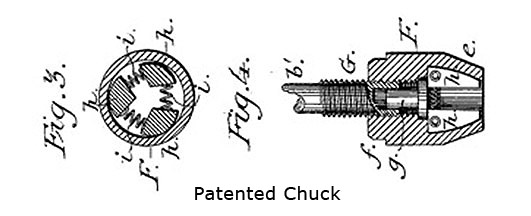
Another design, a friction plate or gear guide, used to control
pressure on a main gear against a pinion, was used on many hand
drills in Goodell-Pratt's line and continued by Millers Falls
Co. after 1931.
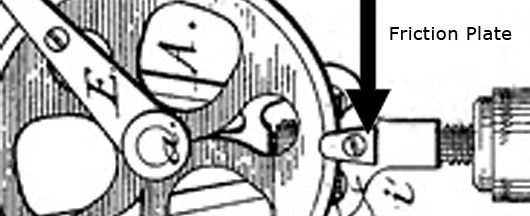
Other improvements were used on dozens of drill models, made by
Goodell-Pratt Co. and later by the Millers Falls Co.
The Hand Drill No. 655, as mentioned above, evolve from
Hand Drill No. 4-1/2 introduced around 1896. In 1897 Chas. A.
Strelinger & Co. published a catalog titled "Wood Workers' Tools
being a catalogue of Tools, Supplies, Machinery and Similar
Goods". The catalog listed and illustrated several drills and
braces manufactured by the Goodell Brothers Co. The Hand Drill
No. 4-1/2 was one of them.
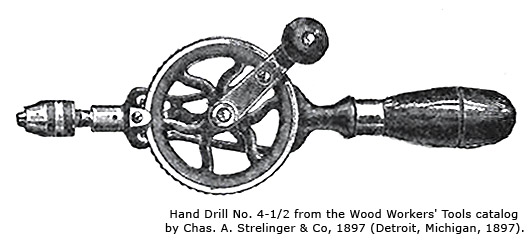
The description provided in the catalog is rather laconic: Hand
Drill No. 4-1/2 - Hold sizes 0 to 5/32. 8 drill points furnished
with each drill. Price - $1.25.
More information is provided in the catalog No. 7, issued in
1905:
Capacity 0 to 5/32 inch. The frame is of malleable iron, strong
and light. The large and small gears are both cut, and run
smoothly without hitching. The steel chuck is a model one, with
knurled nut, well finished, and three hardened steel jaws which
hold equally well the Fluted Drills or any Twisted Drill.
Polished Wood Handle with a Screw Cap in Cocobolo.
Frame - malleable iron, well Japanned. Gears - cut teeth, nickel
plated. Guard - both gears are held together by steel guard,
having every advantage of a double geared drill.
The drill was sold by a dozen for $20.00. (Price of one drill
would be $1.67).
Thirty years later the Goodell-Pratt Co. decided to issue
another version of the small drill based on the same frame and
gear but larger chuck and cheaper handle.
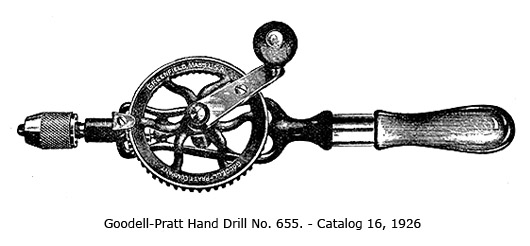
The description from the catalog No. 16 issued in 1926:
Capacity 0 to 1/4 inch. This drill will be welcomed by many, as it
affords unusual value in hand drill of 1/4 inch capacity. It is fitted with a comfortable Hardwood Handle
with a black finish. The Frame is of Malleable Iron nicely
finished in glossy black enamel. The Gear Teeth are all machine
cut. The Pinion is steel, and Large Gear is finished in red
enamel. The Gears are held in mesh by a hardened steel Guard.
The all-steel Chuck has three hardened steel
jaws for holding Round Shank Drills (bits) 0 to 1/4 inch in diameter. Length - 11-3/4 inches. Net weight - 15
ounces. No Drills (bits) furnished with this tool. Price - $2.00 each.
The new drill was cheaper than the No. 4-1/2
drill, which in 1926, was priced at $2.70.
|